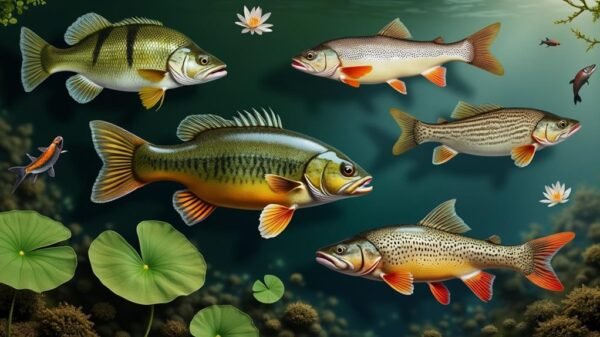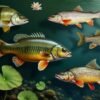When you're fishing in local lakes, you'll find that largemouth bass, rainbow trout, and bluegill are some of the most reliable species to catch. Largemouth bass love warmer waters near structures like rocks and logs, making them exciting targets. Rainbow trout prefer cooler temperatures, often hiding in deeper areas. Bluegill, with their smaller size, are perfect for novice anglers, offering fun for the whole family. Remember, the best times to fish are early mornings and late evenings. Understanding their habits and habitats will enrich your fishing experience, and there's much more to discover about these fascinating fish!
Understanding Local Ecosystems
Local ecosystems consist of intricate networks where diverse species, including freshwater fish like largemouth bass and trout, interact with their surroundings. Understanding these ecosystems involves recognizing the interconnections that sustain them. Plants, microorganisms, and insects all serve essential functions, contributing to a balanced habitat. Freshwater fish are vital to these systems, enhancing the diversity and health of aquatic life.
When exploring local lakes, observe how these species depend on one another. For instance, aquatic plants provide shelter and nutrition for fish, while fish help regulate algae populations. This harmonious interaction is a delicate balance of life. By studying these relationships, you can grasp the importance of conserving these habitats.
For those interested in making a difference, consider engaging with local conservation organizations like the Sierra Club or participating in community clean-up initiatives. Advocating for sustainable practices can significantly impact these ecosystems. Remember, every small effort contributes to preserving the ecological web. Embracing this knowledge empowers you to make informed choices that benefit not just the fish but the entire ecosystem.
Common Species Overview

Many freshwater lakes host a variety of fish species, each fulfilling a distinct role in their ecosystem. Popular species include largemouth bass, rainbow trout, and bluegill. These fish not only offer exciting experiences for anglers but also contribute to the equilibrium of the aquatic environment. Freshwater fish can be grouped based on their temperature preferences, with species like brook trout flourishing in cooler, oxygen-rich waters, while warm-water species such as largemouth bass are frequently located in shallower regions.
Largemouth bass, recognized for their vigorous fight, are a top choice among sport fishers. They thrive in warmer waters and are often found near structures like submerged rocks and fallen trees. Rainbow trout, conversely, favor cooler, clearer waters, making them a favorite for anglers fishing in streams or lakes situated at higher elevations.
Panfish, such as bluegill and crappie, are excellent for novice anglers. They are plentiful and easy to catch, making them ideal for family outings or leisurely days by the lake.
Each species plays a vital role in the health of the lake. Their feeding behaviors help regulate insect populations, while their presence signals a well-balanced ecosystem. By familiarizing yourself with these common freshwater fish, you can better appreciate the rich diversity of life in local lakes. So grab your fishing gear, enjoy the great outdoors, and dive into the thrilling world of freshwater fishing right in your own backyard.
Identifying Key Characteristics

When you're fishing, being able to identify different fish species enhances your experience. Start by examining the shape of their bodies. For example, the Largemouth Bass has a streamlined, elongated body, whereas Bluegills are typically round and compact. The color patterns are also significant. Largemouth Bass usually have a dark green coloration with a prominent lateral line, while Crappies feature distinctive spots and stripes.
Next, observe the fins. Trout, such as Rainbow Trout, have small fins and a streamlined body, which allow for agile swimming. In contrast, Catfish, like the Channel Catfish, have long, whisker-like barbels that aid in sensing their environment. Size matters too; species like Northern Pike can grow several feet long, while smaller fish such as Bluegills are only a few inches in length.
Habitat Preferences

Understanding the habitat preferences of various fish species can significantly improve your fishing approach. Each fish has its preferred locations where it feels secure and thrives. For example, coldwater fish such as trout and salmon often favor deeper waters during the summer months to maintain their optimal temperature. By recognizing these preferences, you can direct your fishing efforts more effectively and enhance your chances of a successful catch.
Consider these important factors:
- Water Depth: Fish frequently favor particular depths due to temperature and light conditions. Shallow areas warm up quickly, attracting species like bass and panfish.
- Structure: Seek out rocks, submerged logs, or aquatic vegetation. Many fish, including perch and catfish, utilize these structures for shelter and hunting.
- Current: Certain species, like pike, flourish in slower-moving waters, while others, such as trout, prefer faster currents. Observe the flow of the water.
- Temperature: Different fish species, such as walleye and bluegill, have varying temperature preferences. Understanding seasonal changes can lead you to the prime locations.
Effective Fishing Techniques

To enhance your fishing outcomes, mastering essential techniques is vital. Begin by choosing optimal fishing times. Early mornings and late evenings are prime periods, as species like bass and trout exhibit increased activity. Weather conditions matter too—overcast skies can boost your success, while bright sunny days may hinder it. Familiarizing yourself with the importance of underwater structures, such as rocks and submerged logs, can significantly improve your experience, as fish like crappie often congregate around these features.
Next, pay attention to your bait choice. Live bait, including nightcrawlers and shiners, generally attracts more fish than artificial lures. Nonetheless, lures from brands like Rapala or Berkley can be effective, particularly when tailored to the specific species you are targeting. Vary your retrieval speed; sometimes, a slow, steady retrieve works wonders, while at other times, a quick twitch can be more appealing.
Remember to maintain stealth. Fish, including species like catfish and pike, are sensitive to noise and movement, so approach quietly and cast your line smoothly. Additionally, using a longer rod, such as those made by Shimano, allows for greater casting distance and access to hard-to-reach areas.



























